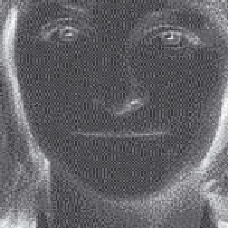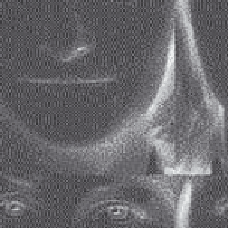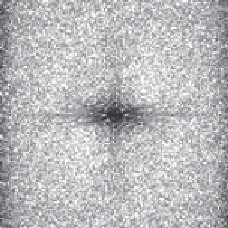Image Processing Reference
In-Depth Information
(a) Face image
(b) Transform of face
(c) Phase of original image
(d) Shifted face image
(e) Transform of shifted face
(f) Phase of shifted image
Figure 2.18
Illustrating shift invariance
This implies that if the frequency domain properties are to be used in image analysis, via
the Fourier transform, then the orientation of the original image needs to be known, or
fixed. It is often possible to fix orientation, or to estimate its value when a feature's
orientation cannot be fixed. Alternatively, there are techniques to impose invariance
to rotation, say by translation to a polar representation, though this can prove to be
complex.
The effect of rotation is illustrated in Figure
2.19
. A face image, Figure
2.19
(a), is
rotated by 90°
to give the image in Figure
2.19
(b). Comparison of the transform of the
original image, Figure
2.19
(c), with the transform of the rotated image, Figure
2.19
(d),
shows that the transform has been rotated by 90° , by the same amount as the image. In fact,
close inspection of Figure
2.19
(c) shows that the major axis is almost vertical, and is
consistent with the major axis of the face in Figure
2.19
(a).
2.6.3
Frequency scaling
By definition, time is the reciprocal of frequency. So if an image is compressed, equivalent
to reducing time, then its frequency components will spread, corresponding to increasing
frequency. Mathematically the relationship is that the Fourier transform of a function of
time multiplied by a scalar λ,
p
(λ
t
), gives a frequency domain function
P
(ω
/ λ), so:






















